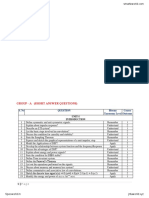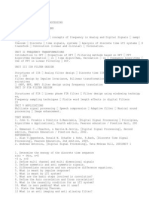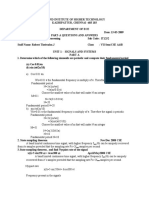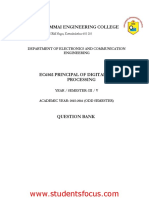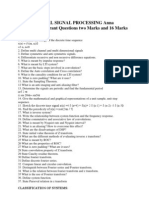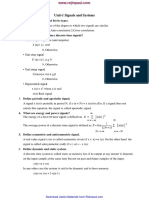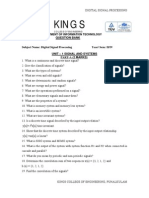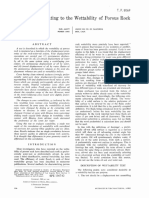Digital Signal Processing Question Bank
Uploaded by
Kishore KrishnaDigital Signal Processing Question Bank
Uploaded by
Kishore KrishnaJNTU World
or
ld
www.alljntuworld.in
GROUP - A (SHORT ANSWER QUESTIONS)
QUESTION
Blooms
Course
Taxonomy Level Outcome
TU
S. No
JN
1
2
3
4
5
6
7
8
9
10
11
12
13
14
15
16
17
18
19
UNIT-I
INTRODUCTION
Define symmetric and anti symmetric signals.
Explain about impulse response?
Describe an LTI system?
List the basic steps involved in convolution?
Discuss the condition for causality and stability?
State the Sampling Theorem
Express and sketch the graphical representations of a unit impulse, step
Model the Applications of DSP?
Develop the relationship between system function and the frequencyResponse
Discuss the advantages of DSP?
Explain about energy and power signals?
State the condition for BIBO stable?
Define Time invariant system.
Define the Parsevals Theorem
List out the operations performed on the signals.
Discuss about memory and memory less system?
Define commutative and associative law of convolutions.
Sketch the discrete time signal x(n) =4 (n+4) + (n)+ 2 (n-1) + (n-2)
Identify the energy and power of x(n) = Aejn u(n).
1|Page
Downloaded From JNTU World (http://www.alljntuworld.in)
Remember
Understand
Understand
Remember
Understand
Remember
Understand
Apply
Apply
Understand
Understand
Remember
Remember
Remember
Remember
Understand
Remember
Apply
Apply
1
2
1
2
1
1
1
2
1
1
1
2
2
2
1
2
1
2
1
www.alljntuworld.in
S. No
1
2
1
2
3
4
Remember
Understand
Remember
Remember
Remember
Analyze
Analyze
Analyze
Understand
Analyze
Remember
Understand
Apply
Apply
Apply
Remember
Apply
Understand
Apply
Apply
3
3
3
3
3
3
3
3
3
3
3
3
3
3
3
3
2
3
2
3
Remember
Understand
6
6
Understand
Remember
Understand
Remember
Understand
Apply
Apply
Understand
Understand
Remember
Remember
Remember
Remember
Understand
Remember
Apply
Apply
Apply
6
6
6
6
6
6
6
6
6
6
6
6
6
6
6
6
6
6
Understand
Remember
Understand
Remember
2
2
2
2
ld
JN
TU
3
4
5
6
7
8
9
10
11
12
13
14
15
16
17
18
19
20
Illustrate the aliasing effect? How can it be avoided?
UNIT-II
DISCRETE FORUIER SERIES
Define discrete fourier series?
Distinguish DFT and DTFT
Define N-pint DFT of a sequence x(n)
Define N-pint IDFT of a sequence x(n)
State and prove time shifting property of DFT.
Examine the relation between DFT & Z-transform.
Outline the DFT X(k) of a sequence x(n) is imaginary
Outline the DFT X(k) of a sequence x(n) is real
Express the zero padding ?what are its uses
Analyze about periodic convolution
Define circular convolution.
Distinguish between linear and circular convolution of two sequences
Demonstrate the overlap-save method
Illustrate the sectioned convolution
Demonstrate the overlap-add method
State the difference between i)overlap-save ii)overlap-add method
Compute the values of WNk ,When N=8, k=2 and also for k=3.
Discuss about power density spectrum of the periodic signal
Compute the DTFT of the sequence x(n)=a n u(n) for a<1
Show the circular convolution is obtained using concentric circle method?
UNIT-III
FAST FOURIER TRANSFORM
Why FFT is needed?
What is the speed improvement factor in calculation 64-point DFT of
sequence using direct computation and FFT algorithm
what is the main advantages of FFT?
calculate N=2048, the number of multiplications required usingDFT is
calculate N=2048, the number of multiplications required using FFT is
calculate, the number of additions required usingDFT is
calculate N=2048, the number of additions required using FFT is
What is FFT
What is radix-2 FFT
What is decimation in-time algorithm
What is decimation in frequency algorithm
What are the diffences and similarities between DIF and DIT algorithms
What is the basic operation of DIT algorithm
what is the basic operation of DIF algorithm
Draw the butterfly diagram of DIT algorithm
How can we calculate IDFT using FFT algorithm
Draw the 4-point radix-2 DIT-FFT butterfly structure for DFT
Draw the 4-point radix-2 DIF-FFT butterfly structure for DFT
What are the Applys of FFT algorithms
Draw the Radix-N FFT diagram for N=6
UNIT-IV
REALIZATION OF DIGITAL FILTERS
Define Z-transform and region of converges
what are the properties of ROC
Write properties of Z-transform
Find z-transform of a impulse and step signals
Blooms
Course
Taxonomy Level Outcome
Apply
1
or
1
2
3
4
5
6
7
8
9
10
11
12
13
14
15
16
17
18
19
20
QUESTION
20
JNTU World
2|Page
Downloaded From JNTU World (http://www.alljntuworld.in)
www.alljntuworld.in
S. No
1.
2.
3.
4.
ld
what are properties of chebyshev filter
Give the equation for the order of N and cutoff frequency of butter worth
filter
What is an IIR filter?
What is meant by frequency warping? What is the cause of this effect?
Distinguish between butter worth and chebyshev filter
How can design digital filters from analog filters
what is bilinear transformation and properties of bilinear transform
what is impulse invariant method of designing IIR filter
Distinguish IIR and FIR filters
Distinguish analog and digital filters
Give the equation for the order N, major, minor axis of an ellipse in case of
chebyshev filter?
List the Butterworth polynomial for various orders
Write the various frequency transformations in analog domain?
What are the advantages of Chebyshev filters over Butterworth filters
What do you understand by backward difference
Write a note on pre warping.
What are the specifications of a practical digital filter
Write the expression for the order of chebyshev filter and Butterworth filter
UNIT-VI
FIR DIGTAL FILTERS
what is mean by FIR filter? and What are advantages of FIR filter?
What is the necessary and sufficient condition for the linear phase
characteristic of a FIR filter?
List the well known design technique for linear phase FIR filter design?
For what kind of Apply, the symmetrical impulse response can be used?
Under what conditions a finite duration sequence h(n) will yield constant
TU
5.
6.
7.
8.
9.
10.
11.
12.
13.
what are the different methods of evaluating inverse Z-transform
Define system function
Find The Z-transform of the finite-duration signal x(n)={1,2,5,7,0,1}
What is the difference between bilateral and unilateral Z-transform
What is the Z-transform of the signal x(n)=Cos(won) u(n).
With reference to Z-transform, state the initial and final value theorems?
What are the basic building blocks of realization structures?
Define canonic and non-canonic structures.
Draw the direct-form I realization of 3rd order system
What is the main advantage of direct-form II realization when compared to
Direct-form I realization?
what is advantage of cascade realization
Draw the parallel form structure of IIR filter
Draw the cascade form structure of IIR filter
what is traspostion theorem and transposed structure
Transfer function for IIR Filters
Transfer function for FIR Filters
UNIT-V
IIR DIGTAL FILTERS
Give the magnitude function of butter worth filter. What is the effect of
varying order of N on magnitude and phase response?
Give any two properties of butter worth low pass filter
Blooms
Course
Taxonomy Level Outcome
2
Evaluate
Understand
2
2
Understand
2
Evaluate
2
Evaluate
2
Analyze
4
Understand
4
Remember
4
Understand
4
Remember
JN
14.
15.
16.
17.
18.
19.
20.
1.
2.
3.
4.
5.
Evaluate
Understand
Understand
Evaluate
Understand
Remember
4
4
4
4
4
4
Understand
Remember
Understand
Remember
5
5
Evaluate
Understand
Understand
Evaluate
Evaluate
Analyze
Understand
Remember
Understand
5
5
5
5
5
5
5
5
5
Remember
Evaluate
Understand
Understand
Evaluate
Evaluate
Analyze
5
5
5
5
5
5
5
Understand
Remember
8
8
Understand
Remember
Evaluate
8
8
8
or
15
16
17
18
19
20
QUESTION
5
6
7
8
9
10
11
12
13
14
JNTU World
3|Page
Downloaded From JNTU World (http://www.alljntuworld.in)
www.alljntuworld.in
S. No
20.
TU
1.
2.
3.
4.
5.
6.
7.
8.
9.
10.
11.
12.
13.
14.
15.
16.
group delay in its frequency response characteristics and not the phase delay?
What is Gibbs phenomenon?
What are the desirable characteristics of the windows?
Compare Hamming window with Kaiser window.
Draw impulse response of an ideal lowpass filter.
What is the principle of designing FIR filter using frequency sampling
method?
For what type of filters frequency sampling method is suitable?
What is the effect of truncating an infinite Fourier series into a finite series
What is a Kaiser window? In what way is it superior to other window
functions?
Explain the procedure for designing FIR filters using windows.
What are the disadvantage of Fourier series method ?
Draw the frequency response of N point Bartlett window
Draw the frequency response of N point Blackman window
Draw the frequency response of N point Hanning window
What is the necessary and sufficient condition for linear phase characteristics
in FIR filter.
Give the equation specifying Kaiser window.
UNIT-VII
MULTIRATE DIGITAL SIGNAL PROCESSING
What is decimation by factor D
What is interpolation by factor I
Find the spectrum of exponential signal
Find the spectrum of exponential signal decimated by factor 2.
Find the spectrum of exponential signal interpolated by factor 2
Explain the term up sampling and down sampling
What are the Applys of multi rate DSP
What does multirate mean?
Why should I do multirate DSP?
What are the categories of multirate?
What are "decimation" and "downsampling"?
What is the "decimation factor"?
Why decimate?
Is there a restriction on decimation factors I can use?
Which signals can be downsampled?
What happens if I violate the Nyquist criteria in downsampling or
decimating?
Can I decimate in multiple stages?
How do I implement decimation
What computational savings do I gain by using a FIR decimator?
How much memory savings do I gain by using a FIR decimator?
UNIT-VIII
FINITE WORDLENGTH EFFECTS
What are the effects of finite word length in digital filters?
List the errors which arise due to quantization process.
Discuss the truncation error in quantization process.
Write expression for variance of round-off quantization noise.
Define limit cycle Oscillations, and list out the types.
When zero limit cycle oscillation and Over flow limit cycle oscillation has
occur?
Why? Scaling is important in Finite word length effect.
What are the differences between Fixed and Binary floating point number
JN
17.
18.
19.
20.
1.
2.
3.
4.
5.
6.
7.
8.
Understand
Understand
Evaluate
Evaluate
Analyze
8
8
8
8
8
Understand
Remember
Understand
8
8
8
Remember
Evaluate
Understand
Understand
Evaluate
Evaluate
8
8
8
8
8
8
Analyze
Understand
Remember
Understand
Remember
Evaluate
Understand
Understand
Evaluate
Evaluate
Analyze
Understand
Remember
Understand
Remember
Evaluate
Understand
7
7
7
7
7
7
7
7
7
7
7
7
7
7
7
7
Understand
Evaluate
Evaluate
Analyze
7
7
7
7
Remember
Understand
Understand
Evaluate
Evaluate
Evaluate
7
4
4
4
4
4
Understand
Evaluate
7
7
ld
14.
15.
16.
17.
18.
19.
Blooms
Course
Taxonomy Level Outcome
or
11.
12.
13.
QUESTION
6.
7.
8.
9.
10.
JNTU World
4|Page
Downloaded From JNTU World (http://www.alljntuworld.in)
www.alljntuworld.in
JNTU World
S. No
16.
17.
18.
19.
20.
representation?
What is the error range for Truncation and round-off process?
What do you understand by a fixed-point number?
What is meant by block floating point representation? What are its
advantages?
What are the advantages of floating point arithmetic?
How the multiplication & addition are carried out in floating point arithmetic?
What do you understand by input quantization error?
What is the relationship between truncation error e and the bits b for
representing a decimal into binary?
What is meant rounding? Discuss its effect on all types of number
representation?
What is meant by A/D conversion noise?
What is the effect of quantization on pole location?
What is meant by quantization step size?
How would you relate the steady-state noise power due to quantization and
the b bits representing the binary sequence?
Evaluate
Analyze
Remember
4
7
7
Understand
Understand
Evaluate
Evaluate
7
7
4
4
ld
12.
13.
14.
15.
Blooms
Course
Taxonomy Level Outcome
Evaluate
Understand
Evaluate
Evaluate
Analyze
4
4
4
4
or
9.
10.
11.
QUESTION
GROUP - II (LONG ANSWER QUESTIONS)
QUESTION
S. No
Blooms
Course
Taxonomy Level Outcome
UNIT-I
INTRODUCTION
Identify linear system in the following:
a)
y n ax n b
c)
Identify a time-variant system.
a)
yn e
b)
d)
6
7
8
9
Apply
Evaluate
Apply
Evaluate
Remember
Apply
Remember
Apply
yn x(n )
2
b)
d) y
n nx(n)
yn x(n) x(n 1)
y n x(n) x(n 1)
c)
Determine the impulse response and the unit step response of the systems
described by the difference equation y(n) = 0.6y(n-1)-0.08 y(n-2) + x(n).
The impulse response of LTI system is
h(n)={1 2 1-1} Determine the response of the system if input is x(n)={1 2
31}
Determine the output y(n) of LTI system with impulse response
h(n)= an u(n). a<1 When the input is unit input sequence that is x(n)=u(n)
Determine impulse response for cascade of two LTI systems havimg Impulse
responses of
H1(n)=(1/2)nu(n)
H2(n)=(1/4)nu(n)
Given the impulse response of a system as h(k)=a ku(k)
determine the range of a for which the system is stable
Determine the range of a and bfor which the system is stable with impulse
response
JN
yn x(2n) b)
yn nx(n) d)
yn x n 2
x n
y n x(n) x(n 1)
c)
Identify a causal system.
a)
yn x n
Understand
TU
yn e
x n
5|Page
Downloaded From JNTU World (http://www.alljntuworld.in)
www.alljntuworld.in
S. No
13
14
15
2
3
a) h(n)=2nu(-n)
b)sin
c)h(n)=(n)+sinn
d) h(n)=e2nu(n-1)
Find the Discrete convolution for the following sequences
a)u(n)*u(n-3)
b)x(n)= cos
u(n)*u(n-1)
Determine the impulse response of following causal system
Y(n)-2cosy(n-1)+y(n-2)=x(n)
Determine the stability of the system
Y(n)-(5/2)y(n-1)+y(n-2)=x(n)-x(n-1)
Find the response of the following difference equation
i)y(n)+y(n-1)=x(n) where x(n)=cos2n
ii)y(n)-5y(n-1)+6y(n-2)=x(n) for x(n)=n
Calculate the frequency response for the LTI systems representation
i) H1(n)=(1/2)nu(n)
ii)h(n)=(n)-(n-1)
UNIT-II
DISCRETE FORUIER SERIES
Determine the fourier series spectrum of signals
i)x(n)=cos2n
ii)cosn/3
iii)x(n) is periodic with period N=4 and x(n)={1 1 0 0}
Determine fourier transform and sketch energy density spectrum of signal
X(n)=|a|
-1<a<1
Determine fourier transform and sketch energy density spectrum of signal
X(n)= A 0nL-1
0 otherwise
Derive relation between fourier transform and z-transform
Let X(k) be a 14-point DFT of a length 14 real sequence x(n).The first 8
samples of X(k) are given by X(0)=12 X(1)=-1+j3 X(2)=3+j4 X(3)=1-j5
X(4)=-2+2j X(5)=6+j3 X(6)=-2-j3 X(7)=10.Determine the remaining samples
compute DFT of a sequence (-1)n for N=4
Fnd the DFT of casual 3-sample averager
Fnd the DFT of non-casual 3-sample averager
Find 4-point DFT of the following sequences
(a) x(n)={1 -1 0 0} (b) x(n)={1 1 -2 -2} (c) x(n)=2n (d) x(n)=sin(n/2)
Determine the circular convolution of the two sequences x1(n)={1 2 3 4}
x2(n)={1 1 1 1} and prove that it is equal to the linear convolution of the
same
Find the output y(n) of a filter whose impulse response is h(n) = {1 1 1} and
input signal x(n) = {3 -1 0 1 3 2 0 1 2 1}. Using Overlap add overlap save
method
Find the output y(n) of a filter whose impulse response is h(n) = {1 11} and
input signal x(n) = {3 -1 0 1 3 2 0 1 2 1}. Using Overlap add method
Determine the impulse response for the cascade of two LTI systems having
impulse responses h1(n)=(1/2)^n* u(n) h2(n)=(1/4)^n*u(n)
Find the output sequence y(n)if h(n)={1 1 1 1} and x(n)={1 2 3 1} using
circular convolution
Find the convolution sum of x(n) =1 n = -2 0 1 = 2 n= -1 = 0 elsewhere and
h(n) = (n) (n-1) + ( n-2) - (n-3)
UNIT-III
TU
4
5
H(n)= an n0
bn n<0
For each impulse response listed below determine whether the corresponding
system is (i) causal (ii) stable
6
7
8
9
JN
10
11
12
13
14
15
Understand
Apply
ld
12
Blooms
Course
Taxonomy Level Outcome
Remember
Evaluate
Apply
or
11
QUESTION
10
JNTU World
6|Page
Downloaded From JNTU World (http://www.alljntuworld.in)
Remember
Remember
Analyze
Analyze
Remember
Understand
3
3
Apply
Apply
Apply
Remember
3
3
3
3
Apply
Understand
Apply
Apply
3
3
Apply
3
Analyze
www.alljntuworld.in
S. No
5
6
7
8
9
10
FAST FOURIER TRANSFORM
Find the DFT of a sequence x(n)={1 2 3 4 4 3 2 1} using DFT algorithm.
Find the 8-pont DFT of sequence x(n)={1 1 1 1 1 0 0 0}
Compute the eight-point DFT of the sequence
X(n)= 1
0n7
0 otherwise
by using DIT DIF algorithms
Compute 4-point DFT of a sequence x(n)={0 1 2 3} using DIT DIF
algorithms
Compute IDFT of sequence X(K)={7 -.707-j.707 j 0.707-j0.707 1
0.707+j0.707 j - .707+j.707}
Compute the eight-point DFT of the sequence x(n)={0.5 0.5 0.5 0.5 0 0 0 0}
using Radix DIT algorithm
Compute the eight-point DFT of the sequence x(n)={0.5 0.5 0.5 0.5 0 0 0 0}
using radix DIF algorithm
Compute the DFT of a sequence x(n)={1 -1 1 -1} using DIT algorithm
Evaluate and compare the 8-point for the following sequences using DIT-FFT
algorithm.
a)x1(n)= 1 for -3n3
b) x2(n)= 1 for 0n6
0 otherwise
0 otherwise
Given x(n)=2n and N=8 find X(k) using DIT-FFT algorithm
11
13
14
TU
15
Compute the DFT of the sequence x(n) =cos
where N=4 using DIF FFT
algorithm.
Find the IDFT of sequence X(k)={1 1+j 2 1-2j 0 1+2j 0 1-j} using DIF
algorithm
Find the IDFT of sequence X(k)={8 1+j2 1-j 0 1 0 1+j 1-j2}
Draw the signal flow graph for 16-point DFT using a) DIT algorithm b)
DIF algorithm
Find the IDFT of a sequence x(n)={0 1 2 3 4 5 6 7} using DIT-FFT
algorithm.
UNIT-IV
REALIZATION OF DIGITAL FILTERS
Determine the z-transform of the following
12
Blooms
Course
Taxonomy Level Outcome
i)x(n)=n(-1)nu(n)
x(n)=n2u(n)
iii)x(n)=(-1)n cos[ n] u(n)
Find the input x(n) of the system if the impulse response h(n) and output y(n)
are shown below h(n)={ 1 2 3 2} y(n)={ 1 3 7 10 10 7 2}
Determine the z-transform and sketch the ROC of the following signal
x(n)= ( )n n0 ; ()-n
n<0
Determine the convolution of the pairs of signals by means of z-transform
X1(n)=(1/2)n u(n)
X2(n)= cosn u(n)
Determine the causal signal x(n) having the Z-tranform x(z)=
1
(1 Z 1)(1 Z 1) 2
JN
4
5
Understand
Evaluate
Evaluate
6
6
6
Evaluate
Analyze
ld
QUESTION
Apply
Apply
Understand
Apply
6
6
Apply
Understand
Evaluate
Evaluate
Evaluate
6
6
Understand
Understand
Remember
Remember
Remember
Apply
Remember
Apply
or
1
2
3
JNTU World
Find the inverse a-transform of X(z)=
partial fraction method.
Find inverse Z transfer of
X(Z) =
roc |z>2 using
if ROC : |Z| > 1
7|Page
Downloaded From JNTU World (http://www.alljntuworld.in)
www.alljntuworld.in
S. No
JNTU World
QUESTION
Blooms
Course
Taxonomy Level Outcome
(2) ROC : |Z| < 0.5
(3) ROC : 0.5 < |Z| <1
Determine the transfer function and impulse response of the system
y(n)
y(n 1) +
y(n 2) = x(n) +
Find the inverse z-transform of the system
14
15
1.
2.
3.
X(z)=
if the i)roc z|<1/2 ii)roc z|>3
iii)roc 1/2
<z|<3
Obtain the cascade and parallel form realizations for the following systems Y
(n) = -0.1(n-1) + 0.2 y (n-2) + 3x (n) +3.6 x (n-1) +0.6 x (n-2)
Obtain the Direct form II y (n) = -0.1(n-1) + 0.72 y(n-2) + 0.7x(n) -0.252 x(n2)
Find the direct form II H (z) =8z-2+5z-1+1 / 7z-3+8z-2+1
Obtain the i) Direct forms ii) cascade iii) parallel form realizations for the
following systems y (n) = 3/4(n-1) 1/8 y(n-2) + x(n) +1/3 x(n-1)
The step response of an LTI system is
n-1
S(n)=
u(n+2) find the system function H(z).
Obtain the i) Direct forms ii) parallel form realizations for the following
systems y (n) = x(n) +1/3 x(n-1)-1/5 x(n-2)
UNIT-V
IIR DIGTAL FILTERS
Given the specification p=1dB, s=30dB,p=200rad/sec, s=600rad/sec.
Determine the order of the filter
Determine the order and the poles of lowpass butter worth filter that has a 3
dB attenuation at 500Hz and an attenuation of 40dB at 1000Hz
Understand
Remember
Remember
4
4
Remember
Understand
Remember
For the given specification design an analog Butterworth filter
0.9H(j)1 for 00.2 H(j)0.2 for 0.4
Remember
Evaluate
Design an analog Butterworth filter that as a -2dB pass band attenuation at a
frequency of 20rad/sec and at least -10dB stop band attenuation at 30rad/sec
5.
For the given specifications find the order of butter worth filter p=3dB,
s=18dB, fp=1KHz, fs=2KHz.
6.
Design an analog butter worth filter that has p=0.5dB, s=22dB, fp=10KHz,
fs=25KHz Find the pole location of a 6th order butter worth filter with c=1
rad/sec
Given the specification p=3dB, s=16dB, fp=1KHz, fs=2KHz. Determine the
order of the
filter Using cheby shev approximation. find H(s).
JN
7.
Apply
Understand
TU
4.
ld
12
13
Understand
x(n 1).
or
11
10
Evaluate
5
Understand
5
Understand
Understand
8.
Obtain an analog cheby shev filter transfer function that satisfies the
constraints 0H(j)1 for 02
Evaluate
9.
Determine the order and the poles of type 1 low pass cheby shev filter that has
a 1 dB ripple in the passband and passband frequency p =1000 and a
stopband of frequency of 2000 and an attenuation of 40dB or more.
Evaluate
10.
For the given specifications find the order of chebyshev-I p=1.5dB, s=10dB,
p =2rad/sec, s =30 rad/sec.
Analyze
8|Page
Downloaded From JNTU World (http://www.alljntuworld.in)
www.alljntuworld.in
JNTU World
S. No
QUESTION
Blooms
Course
Taxonomy Level Outcome
Understand
5
11.
For the analog transfer function H(s)=
impulse invariance method .Assume T=1sec
Determine H(z) using
12.
For the analog transfer function H(s)=
using impulse invariance method .Assume T=1sec
Understand
Remember
Determine H(z)
Design a third order butter worth digital filter using impulse invariant
technique .Assume sampling period T=1sec
ld
13.
Remember
14.
15.
For the analog transfer function H(s)=
bilinear method Assume T=1sec
2.
UNIT-VI
FIR DIGTAL FILTERS
Determine the frequency response of FIR filter defined by y(n)=0.25x(n)+x(n1)+.25x(n-2) Calculate the phase delay and group delay.
The frequency response of Linear phase FIR filter is given by
H(ejw)=cos +
cos
Evaluate
Understand
Remember
Determine H(z) using
1.
or
An analog filter has a transfer function H(s)=
.Design a digital filter equivalent to this using impulse invariant method for
T=1Sec
. Determine the impulse response(n).
If the frequency response of a linear phase FIR filter is given by
H(ejw)= e-jw2(.30+0.5cos+0.3cos2) Determine filter coefficients.
Understand
4.
Design an ideal highpass filter with a frequency respose
Remember
5.
Hd(ejw)=1 for | 0 for |
Find the values of h(n) for N=11.Find H(z).plot magnitude response.
Design an ideal bandpass filter with a frequency respose
Evaluate
6.
Hd(ejw)=1 for | 0 for |
Find the values of h(n) for N=11.Find H(z).plot magnitude response.
Design an ideal band reject filter with a frequency respose
JN
TU
3.
7.
8.
Hd(ejw)=1 for | and | 0 for otherwise
Find the values of h(n) for N=11.Find H(z).plot magnitude response.
Design an ideal differentiate
H(ejw)=j -
Using a)rectangular window b)Hamming window with N=8.plot frequency
response in both cases.
Determine the filter coefficients h(n) obtained by sampling
8
Understand
8
Evaluate
Hd(ejw)=e-j(N-1)/2
9.
8
Understand
0| /2
=0
/2<| for N=7
using frequency sampling method design a bandpass filter with following
9|Page
Downloaded From JNTU World (http://www.alljntuworld.in)
Evaluate
www.alljntuworld.in
JNTU World
S. No
QUESTION
Blooms
Course
Taxonomy Level Outcome
specifications
Sampling frequency F=8000Hz
Cut off frequency fc1=1000Hz fc2=3000Hz
Determine the filter coefficients for N=7
Compare IIR and FIR filters
Design an FIR filter
approximating the
ideal frequency response
Hd(ejw)=e-j
14.
15.
b) Explain the need for the use of window sequence in the design of FIR
filter. Describe the window sequence generally used and compare the
properties.
Design a HPF of length 7 with cut off frequency of 2 rad/sec using Hamming
window. Plot the magnitude and phase response.
Explain the principle and procedure for designing FIR filter using rectangular
window
UNIT-VII
MULTIRATE DIGITAL SIGNAL PROCESSING
Derive the expression for decimation by factor D
Derive the expression for interpolation by factor I
Write notes on sampling rate conversion by a rational factor I/D
Write notes on filter design and implementation for sampling rate conversion
Explain poly phase filter structures
Explain time variant filter structures
Write notes on the Apply of multi rate digital signal processing
TU
1.
2.
3.
4.
5.
6.
7.
=0
| for N=13Determine filter coefficients.
Using a rectangular window technique design a low pass filter with pass band
gain of unity, cutoff frequency of 100Hz and working at a sampling frequency
of 5KHz.The length of the impulse response should be7.
a) Prove that an FIR filter has linear phase if the unit sample response
satisfies the condition h(n)= h(M-1-n), n =0,1,.. M-Also discuss
symmetric and anti symmetric cases of FIR filter.
What are the Applys of multirate digital signal processing. b) Design a
interpolator which meet the following specifications. Interpolation factor = 20
Pass band : 0f< 90
Transitions band : 90<f< 100
Input sampling rate : 10 KHz , Ripple = 1=0.01,2=0.001.
UNIT-VIII
FINITE WORDLENGTH EFFECTS
Explain the output noise due to A/D conversion of the input x (n).
Write short note on (a) Truncation and rounding (b) Coefficient Quantization.
Explain the errors introduced by quantization with necessary expression
JN
8.
1.
2.
3.
4.
5.
8
8
Remember
Understand
Remember
Evaluate
Understand
Analyze
Evaluate
Analyze
Analyze
Analyze
Evaluate
7
7
7
7
7
7
7
Analyze
Evaluate
Evaluate
Understand
7
4
4
Apply
or
13.
12.
Analyze
Understand
ld
10.
11.
(i). Discuss the various common methods of quantization.
(ii). Explain the finite word length effects in FIR digital filters.
Describe the quantization in floating point realization of IIR digital filters.
4
Understand
(i). Explain the characteristics of limit cycle oscillation with respect to the
system described by the difference equation:
10 | P a g e
Downloaded From JNTU World (http://www.alljntuworld.in)
www.alljntuworld.in
S. No
JNTU World
QUESTION
Blooms
Course
Taxonomy Level Outcome
y(n) = 0.95y(n 1) + x(n); x(n) = 0 and y(-1) = 13. Determine the dead band
range of the system.
8.
9.
10.
11.
Evaluate
Analyze
Evaluate
Analyze
4
7
7
Evaluate
Evaluate
12.
(ii). Compare the truncation and rounding errors using fixed point and floating
point representation.
(i). what is quantization of analog signals? Derive the expression for the
quantization error. (ii). Explain coefficient quantization in IIR filter.
(i). How to prevent limit cycle oscillations? Explain.
(ii). what is meant by signal scaling? Explain.
Discuss in detail the errors resulting from rounding and truncation.
Explain the limit cycle oscillations due to product round off and overflow
errors.
Explain the characteristics of a limit cycle oscillation with respect to the
system described by the equation y(n) = 0.45y(n 1) + x(n) when the product
is quantized to 5 bits by rounding. The system is excited by an input x(n) =
0.75 for n = 0 and x(n) = 0 for n 0. Also determine the dead band of the
filter.
Consider the LTI system governed by the equation, y(n) + 0.8301y(n 1) +
0.7348y(n 2) = x(n 2). Discuss the effect of co-efficient quantization on
pole location , when the coefficients are quantized by
3-bits by truncation
4-bits by truncation
Analyze
ld
7.
(ii). Explain the effects of coefficient quantization in FIR filters
(i). Derive the signal to quantization noise ratio of A/D converter.
or
6.
GROUP - III (ANALYTICAL THINKING QUESTIONS)
QUESTION
TU
S. No
UNIT-I
INTRODUCTION
a) show that the fundamental period Np of the signals
sk(n)= ej2kn/N for k=0 2 ..
is given by Np = N/GCD(k )
where GCD is the greatest common divisor of k and N.
b) what is the fundamental period of this set for N=7?
c) what is it for N=16?
Consider the simple signal processing system shown in below figure. The
sampling periods of the A/D and D/A converters are T=5ms and T = 1ms
respectively. Determine the output ya(t) of the system. If the input is
xa(t) =3 cos 100t + 2 sin 250t ( t in seconds)
The postfilter removes any frequency component above Fs/2.
JN
Blooms
Course
Taxonomy Level Outcome
Determine the response y(n)
Consider the interconnection of LTI systems as shown below
a) Express the overall impulse response in terms of h1(n) h3(n) and h4(n)
b) Determine h(n) when h1(n)={1/2 1/2} h2(n)= h3(n)=(n+1)u(n)
h4(n)=(n-2)
11 | P a g e
Downloaded From JNTU World (http://www.alljntuworld.in)
1
Analyze
Apply
Understand
Apply
www.alljntuworld.in
S. No
JNTU World
QUESTION
Blooms
Course
Taxonomy Level Outcome
c) Determine the response of above system if x(n)= (n+2)+3 (n-1)-4 (n-3)
consider the discrete-time system as shown below
Understand
ld
or
TU
(a) Compute the 10 first samples of its impulse response.
(b) Find the input-output relation.
(c) Apply the input x(n) = {1 1. . . .} and compute the first 10 samples of the
output.
(d) Compute the first 10 samples of the output for the input given in part (c)
by using convolution.
(e) Is the system causal? Is it stable?
UNIT-II
DISCRETE FORUIER SERIES
The linear convolution of length-50 sequence with a length 800 sequence is to
be computed using 64 point DFT and IDFT
a) what is the smallest number of DFT and IDFT needed to compute the linear
convolution using overlap-add method
b) what is the smallest number of DFT and IDFT needed to compute the linear
convolution using overlap-save method
The DTFT of a real signal x(n) is X(F). How is the DTFT of the following
signals related to
X(F). (a) y(n)=x(-n) (b) r(n)=x(n/4) (c) h(n) =j nx(n)
Consider the sequences x1(n) = {0 1 2 3 4} x2(n) = {0 1 0 0 0} x3(n) = {1 0
0 0 0} and their 5 point DFT.
(a) Determine a sequence y(n) so that Y(k) =X1(k) X2(k)
(b) Is there a sequence x3(n) such that S(k) =X1(k) X3(k)
Consider a finite duration sequence x(n) = {0 1 2 3 4} (a) Sketch the sequence
s(n) with six-point DFT S(k) = w2k X(k) k=0 1 .....6
(b) Sketch the sequence y(n) with six-point DFT Y(k) = Re |X(k)|
(c) Sketch the sequence v(n) with six-point DFT V(k) = Im|X(k)|
Two eight point sequence x1(n) and x2(n) shown in the Figure below. Their
DFTs X1[k]
and X2[k]. Find the relationship between them.
JN
12 | P a g e
Downloaded From JNTU World (http://www.alljntuworld.in)
Apply
Remember
Analyze
3
Remember
3
Apply
www.alljntuworld.in
S. No
JN
TU
UNIT-III
FAST FOURIER TRANSFORM
Find the IDFT of sequence X(k)={4 1-j2.414 0 1-j.414 0 1+j.414 0 1+j2.414}
using DIF algorithm
Show that the product of two complex numbers (a+jb) and (c+jd) can be
performed with three real multiplications and five additions using the
algorithm
xR = (a-b)d+(c-d)a
xI=(a-b)d+(c+d)b
where x=xR+jxI = (a+jb)(c+jd)
Explain how the DFT can be used to compute N equi-spaced samples of the ztransform of an N-point sequence on a circle of radius r.
Develop a radix-3 decimation-in-time FFT algorithm for N=3n and draw the
corresponding flow graph for N=9. What is the number of required complex
multiplications? Can the operations be performed in place?
Develop a radix-3 decimation-in-frequency FFT algorithm for N=3n and draw
the corresponding flow graph for N=9. What is the number of required
complex multiplications? Can the operations be performed in place?
UNIT-IV
REALIZATION OF DIGITAL FILTERS
Use the one-sided Z-transform to determine y(n) n 0 in the following cases.
(a) y(n) +y(n1)0.25y(n2) = 0; y(1) = y(2) = 1
(b) y(n)1.5y(n1) +0.5y(n2) = 0; y(1) = 1; y(2) = 0
Prove that the fibonacci series can be thought of as the impulse response of
the system
described by the difference equation y(n) = y(n1) +y(n2) +x(n)
Then determine h(n) using Z-transform techniques
Obtain the i) Direct forms ii) cascade iii) parallel form realizations for the
following systems
y (n) = 3/4(n-1) 1/8 y(n-2) + x(n) +1/3 x(n-1)
Find the direct form I cascade and parallel form for
H(Z) = z -1 -1 / 1 0.5 z-1+0.06 z-2
For the LTI system described by the flow graph in figure determine the
difference equation relating the input x(n) to the output y(n)
Remember
Remember
ld
Blooms
Course
Taxonomy Level Outcome
Remember
Apply
Apply
or
QUESTION
JNTU World
Apply
Remember
Apply
Evaluate
Understand
Understand
Remember
Remember
Evaluate
UNIT-V
IIR DIGTAL FILTERS
1.
For the analog transfer function H(s)=
bilinear method
Determine H(z) using
2.
Apply impulse invariant method and find H(z) for H(s)=
3.
Design a chebyshev filter with a maximum pass band attenuation of 2.5dB
at p=20rad/sec and the stopband attenuation of 30dB at s=50rad/sec.
4.
An ideal discrete-time lowpass filter with cutoff frequency c =2/5 was
13 | P a g e
Downloaded From JNTU World (http://www.alljntuworld.in)
www.alljntuworld.in
JNTU World
S. No
QUESTION
Blooms
Course
Taxonomy Level Outcome
designed using impulse invariance from an ideal continuous-time lowpass
filter with cutoff frequency c = 2(4000) rad/s. what was the value of T? is
this value unique? If not, find another value of T consistent with the
information given.
1.
The bilinear transformation is used todesign an ideal discrete-time lowpass
filter with cutoff frequency c =3/5 from an ideal continuous-time lowpass
filter with cutoff frequency c = 2(300) rad/s. what was the value of T? is
this value unique? If not, find another value of T consistent with the
information given.
UNIT-VI
FIR DIGTAL FILTERS
Design a filter with Hd(ej) = e- 3 j, /4 /4
0 for /4 using a Hamming window with N=7.
Understand
ld
5.
Understand
H (w) =1 for | | /3 and | | 2 /3 otherwise for N=11. and find the
response
Remember
3.
Design a FIR filter
whose
frequency
response
H (e j) =
1 /4
3/4
Understand
Design an ideal differentiator with frequency response H (e j) =
jw - using hamming window for N=8 and find the
frequency response.
Remember
Design an ideal Hilbert transformer having frequency response H (e
j) = j - 0 -j 0 for N=11 using rectangular window
Evaluate
Understand
Analyze
Evaluate
Analyze
0 | | 3 /4.
or
2.
Calculate the value of h(n) for N=11 and hence find H(z).
TU
4.
5.
1.
a) Why multirate digital signal processing is needed?
JN
2.
UNIT-VII
MULTIRATE DIGITAL SIGNAL PROCESSING
a)Describe the decimation process with a neat block diagram. b)Consider a
signal x(n)=sin(n)U(n). Obtain a signal with an interpolation factor of 2
b) Design a two state decimator for the following specifications. Decimation
factor = 50 Pass band = 0<f<50 Transitive band = 50f 55 Input sampling =
10 KHz Ripple = 1=0.1,2=0.001.
3.
4.
a) What are the advantages and drawbacks of multirate digital signal
processing b) Design a decimator with the following specification D = 5,
p=,0.025 s=0.0035, s= 0.2 Assume any other required data.
Design one-stage and two-stage interpolators to meet the following
specification:
14 | P a g e
Downloaded From JNTU World (http://www.alljntuworld.in)
www.alljntuworld.in
5.
QUESTION
Input sampling rate:
Passband:
Transition band:
Ripple:
Design a linear pahse FIR filter that satisfies the
following specifications based on a single- stage
and two-stage multirate structure.
Input sampling rate:
Passband:
Transition band:
Blooms
Course
Taxonomy Level Outcome
l=20
10K Hz
0 F 90
90 F 100
1 =10-2 , 2 = 10-3
Analyze
10K Hz
0 F 60
60 F 65
1 =10-1,2 = 10-3
UNIT-VIII
FINITE WORDLENGTH EFFECTS
The output of an A/D is fed through a digital system
whose system function is H (z)=1/(1-0.8z-).Find the
output noise power of the digital system.
1.
or
Ripple:
ld
S. No
JNTU World
Evaluate
Evaluate
The output of an A/D is fed through a digital system
whose system function is H(Z)=0.6z/z-0.6. Find the
output noise power of the digital system=8 bits
3.
Discuss in detail about quantization effect in ADC of signals. Derive the
expression for Pe(n) and SNR.
Understand
4.
A digital system is characterized by the difference equation
y(n)=0.95y(n-1)+x(n).determine the dead band of the system when
x(n)=0 and y(-1)=13.
Understand
5.
Two first order filters are connected in cascaded whose system
functions of the individual sections are H1(z)=1/(1-0.8z- ) and
H2(z)=1/(1-0.9z ).Determine the overall output noise power.
Evaluate
JN
TU
2.
15 | P a g e
Downloaded From JNTU World (http://www.alljntuworld.in)
You might also like
- NRF - R134a-R1234yf Airconditioning Filling Chart67% (3)NRF - R134a-R1234yf Airconditioning Filling Chart1 page
- 9 Ways BMC Helix Itsm Beats The Competition 2No ratings yet9 Ways BMC Helix Itsm Beats The Competition 213 pages
- Ece V Digital Signal Processing (10ec52) NotesNo ratings yetEce V Digital Signal Processing (10ec52) Notes161 pages
- Iliadi - Sand Jet Perforation - Presentation 20171018100% (1)Iliadi - Sand Jet Perforation - Presentation 2017101816 pages
- Emerging Technologies in Information and Communications TechnologyFrom EverandEmerging Technologies in Information and Communications TechnologyNo ratings yet
- Optical and Microwave Technologies for Telecommunication NetworksFrom EverandOptical and Microwave Technologies for Telecommunication NetworksNo ratings yet
- Silica Optical Fiber Technology for Devices and Components: Design, Fabrication, and International StandardsFrom EverandSilica Optical Fiber Technology for Devices and Components: Design, Fabrication, and International StandardsNo ratings yet
- Microwave Filters for Communication Systems: Fundamentals, Design, and ApplicationsFrom EverandMicrowave Filters for Communication Systems: Fundamentals, Design, and ApplicationsNo ratings yet
- Next Generation Wireless Communications Using Radio over FiberFrom EverandNext Generation Wireless Communications Using Radio over FiberNo ratings yet
- Digital Signal Processing Question Bank PDFNo ratings yetDigital Signal Processing Question Bank PDF15 pages
- Group - A (Short Answer Questions) : S. No Blooms Taxonomy Level Course OutcomeNo ratings yetGroup - A (Short Answer Questions) : S. No Blooms Taxonomy Level Course Outcome15 pages
- Digital Signal Processing Imp QuestionsNo ratings yetDigital Signal Processing Imp Questions10 pages
- Ece V Digital Signal Processing (10ec52) NotesNo ratings yetEce V Digital Signal Processing (10ec52) Notes160 pages
- Digital Signal Processing: Unit-1 and 2: Discrete Fourier TransformsNo ratings yetDigital Signal Processing: Unit-1 and 2: Discrete Fourier Transforms5 pages
- EC6502-Principal of Digital Signal Processing - 2013 - Regulation PDFNo ratings yetEC6502-Principal of Digital Signal Processing - 2013 - Regulation PDF13 pages
- EC3492 - DIGITAL SIGNAL PROCESSING-923183941-question Bank DSP 21 RegNo ratings yetEC3492 - DIGITAL SIGNAL PROCESSING-923183941-question Bank DSP 21 Reg18 pages
- Cs2403 Digital Signal Processing Anna University Imporant Questions Two Marks and 16 Marks Question BankNo ratings yetCs2403 Digital Signal Processing Anna University Imporant Questions Two Marks and 16 Marks Question Bank8 pages
- EC3492 - DIGITAL SIGNAL PROCESSING-923183941-question Bank DSP 21 RegNo ratings yetEC3492 - DIGITAL SIGNAL PROCESSING-923183941-question Bank DSP 21 Reg17 pages
- Ece-V-Digital Signal Processing (10ec52) - Notes PDFNo ratings yetEce-V-Digital Signal Processing (10ec52) - Notes PDF161 pages
- EC6502 Principles of Digital Signal Processing 1- By EasyEngineering.netNo ratings yetEC6502 Principles of Digital Signal Processing 1- By EasyEngineering.net116 pages
- Department of Electronics and Communication Engineering: Digital Signal ProcessingNo ratings yetDepartment of Electronics and Communication Engineering: Digital Signal Processing25 pages
- EC6502 Principles of Digital Signal ProcessingNo ratings yetEC6502 Principles of Digital Signal Processing320 pages
- Ece V Digital Signal Processing (10ec52) Notes100% (1)Ece V Digital Signal Processing (10ec52) Notes161 pages
- Objectives:: at The End of The Course, The Student Should Be Able ToNo ratings yetObjectives:: at The End of The Course, The Student Should Be Able To2 pages
- Can LLMs Generate Architectural Design DecisionsNo ratings yetCan LLMs Generate Architectural Design Decisions11 pages
- Trends Networks and Critical Thinking in The 21st CenturyNo ratings yetTrends Networks and Critical Thinking in The 21st Century83 pages
- Academic Performance Satisfaction of Grade 11 StudentsNo ratings yetAcademic Performance Satisfaction of Grade 11 Students6 pages
- The System How Companies Get Theri Shit TogetherNo ratings yetThe System How Companies Get Theri Shit Together103 pages
- Quay Et Al (2022) Dewey's Education Through Occupations As Being-Doing-Knowing Creative Learning UnitsNo ratings yetQuay Et Al (2022) Dewey's Education Through Occupations As Being-Doing-Knowing Creative Learning Units17 pages
- Dhananjay Sharma Vs State of Haryana and Ors On 2 May, 1995No ratings yetDhananjay Sharma Vs State of Haryana and Ors On 2 May, 199521 pages
- Norwegian School Geography and Geographical Education - A New Research Field?No ratings yetNorwegian School Geography and Geographical Education - A New Research Field?8 pages
- Issues in Teacher Leadership Review - Phlong PaulinaNo ratings yetIssues in Teacher Leadership Review - Phlong Paulina2 pages
- SPE-1167-Wettability of Porous Rock by Amott, 1960)No ratings yetSPE-1167-Wettability of Porous Rock by Amott, 1960)7 pages
- Name: Roll No: Sub:: AIM Geometric ModellingNo ratings yetName: Roll No: Sub:: AIM Geometric Modelling9 pages
- Solution Manual for Materials for Civil and Construction Engineers 3rd Edition by Mamlouk 2024 scribd download100% (11)Solution Manual for Materials for Civil and Construction Engineers 3rd Edition by Mamlouk 2024 scribd download54 pages
- Biostatistics - Mean of Continuous SeriesNo ratings yetBiostatistics - Mean of Continuous Series5 pages
- Iliadi - Sand Jet Perforation - Presentation 20171018Iliadi - Sand Jet Perforation - Presentation 20171018
- Modulation and Coding Techniques in Wireless CommunicationsFrom EverandModulation and Coding Techniques in Wireless Communications
- Emerging Technologies in Information and Communications TechnologyFrom EverandEmerging Technologies in Information and Communications Technology
- The IMS: IP Multimedia Concepts and ServicesFrom EverandThe IMS: IP Multimedia Concepts and Services
- Optical and Microwave Technologies for Telecommunication NetworksFrom EverandOptical and Microwave Technologies for Telecommunication Networks
- Drive testing The Ultimate Step-By-Step GuideFrom EverandDrive testing The Ultimate Step-By-Step Guide
- Silica Optical Fiber Technology for Devices and Components: Design, Fabrication, and International StandardsFrom EverandSilica Optical Fiber Technology for Devices and Components: Design, Fabrication, and International Standards
- Microwave Filters for Communication Systems: Fundamentals, Design, and ApplicationsFrom EverandMicrowave Filters for Communication Systems: Fundamentals, Design, and Applications
- Next Generation Wireless Communications Using Radio over FiberFrom EverandNext Generation Wireless Communications Using Radio over Fiber
- Group - A (Short Answer Questions) : S. No Blooms Taxonomy Level Course OutcomeGroup - A (Short Answer Questions) : S. No Blooms Taxonomy Level Course Outcome
- Digital Signal Processing: Unit-1 and 2: Discrete Fourier TransformsDigital Signal Processing: Unit-1 and 2: Discrete Fourier Transforms
- EC6502-Principal of Digital Signal Processing - 2013 - Regulation PDFEC6502-Principal of Digital Signal Processing - 2013 - Regulation PDF
- EC3492 - DIGITAL SIGNAL PROCESSING-923183941-question Bank DSP 21 RegEC3492 - DIGITAL SIGNAL PROCESSING-923183941-question Bank DSP 21 Reg
- Cs2403 Digital Signal Processing Anna University Imporant Questions Two Marks and 16 Marks Question BankCs2403 Digital Signal Processing Anna University Imporant Questions Two Marks and 16 Marks Question Bank
- EC3492 - DIGITAL SIGNAL PROCESSING-923183941-question Bank DSP 21 RegEC3492 - DIGITAL SIGNAL PROCESSING-923183941-question Bank DSP 21 Reg
- Ece-V-Digital Signal Processing (10ec52) - Notes PDFEce-V-Digital Signal Processing (10ec52) - Notes PDF
- EC6502 Principles of Digital Signal Processing 1- By EasyEngineering.netEC6502 Principles of Digital Signal Processing 1- By EasyEngineering.net
- Department of Electronics and Communication Engineering: Digital Signal ProcessingDepartment of Electronics and Communication Engineering: Digital Signal Processing
- Objectives:: at The End of The Course, The Student Should Be Able ToObjectives:: at The End of The Course, The Student Should Be Able To
- Trends Networks and Critical Thinking in The 21st CenturyTrends Networks and Critical Thinking in The 21st Century
- Academic Performance Satisfaction of Grade 11 StudentsAcademic Performance Satisfaction of Grade 11 Students
- Quay Et Al (2022) Dewey's Education Through Occupations As Being-Doing-Knowing Creative Learning UnitsQuay Et Al (2022) Dewey's Education Through Occupations As Being-Doing-Knowing Creative Learning Units
- Dhananjay Sharma Vs State of Haryana and Ors On 2 May, 1995Dhananjay Sharma Vs State of Haryana and Ors On 2 May, 1995
- Norwegian School Geography and Geographical Education - A New Research Field?Norwegian School Geography and Geographical Education - A New Research Field?
- Issues in Teacher Leadership Review - Phlong PaulinaIssues in Teacher Leadership Review - Phlong Paulina
- SPE-1167-Wettability of Porous Rock by Amott, 1960)SPE-1167-Wettability of Porous Rock by Amott, 1960)
- Solution Manual for Materials for Civil and Construction Engineers 3rd Edition by Mamlouk 2024 scribd downloadSolution Manual for Materials for Civil and Construction Engineers 3rd Edition by Mamlouk 2024 scribd download
















